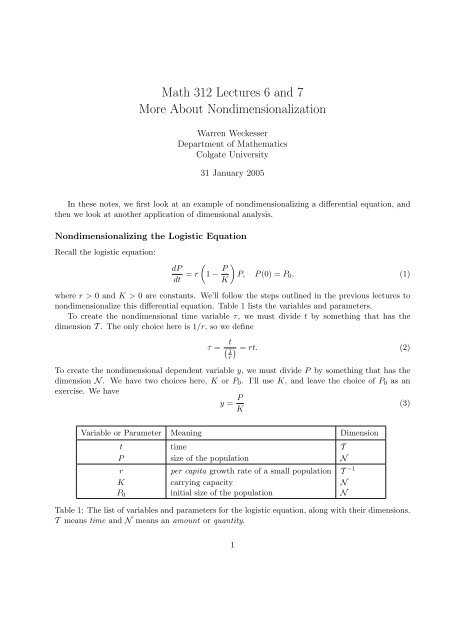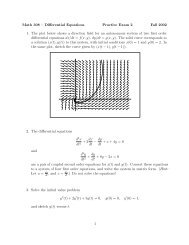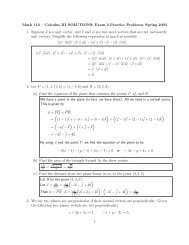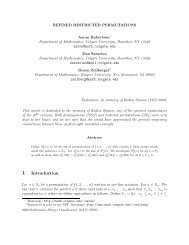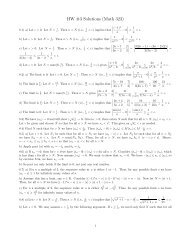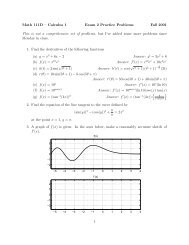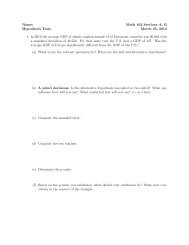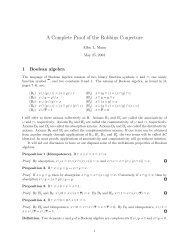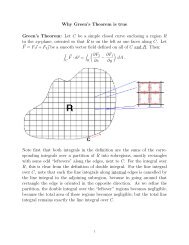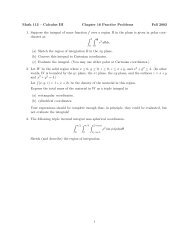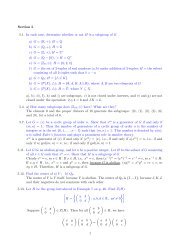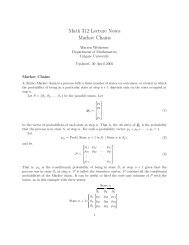Nondimensionalize the logistic equation - Department of Mathematics
Nondimensionalize the logistic equation - Department of Mathematics
Nondimensionalize the logistic equation - Department of Mathematics
You also want an ePaper? Increase the reach of your titles
YUMPU automatically turns print PDFs into web optimized ePapers that Google loves.
Math 312 Lectures 6 and 7More About NondimensionalizationWarren Weckesser<strong>Department</strong> <strong>of</strong> Ma<strong>the</strong>maticsColgate University31 January 2005In <strong>the</strong>se notes, we first look at an example <strong>of</strong> nondimensionalizing a differential <strong>equation</strong>, and<strong>the</strong>n we look at ano<strong>the</strong>r application <strong>of</strong> dimensional analysis.Nondimensionalizing <strong>the</strong> Logistic EquationRecall <strong>the</strong> <strong>logistic</strong> <strong>equation</strong>:dP(1dt = r − P )P, P (0) = P 0 , (1)Kwhere r > 0 and K > 0 are constants. We’ll follow <strong>the</strong> steps outlined in <strong>the</strong> previous lectures tonondimensionalize this differential <strong>equation</strong>. Table 1 lists <strong>the</strong> variables and parameters.To create <strong>the</strong> nondimensional time variable τ, we must divide t by something that has <strong>the</strong>dimension T . The only choice here is 1/r, so we defineτ =t ( 1r) = rt. (2)To create <strong>the</strong> nondimensional dependent variable y, we must divide P by something that has <strong>the</strong>dimension N . We have two choices here, K or P 0 . I’ll use K, and leave <strong>the</strong> choice <strong>of</strong> P 0 as anexercise. We havey = P K(3)Variable or Parameter Meaning Dimensiont time TP size <strong>of</strong> <strong>the</strong> population Nr per capita growth rate <strong>of</strong> a small population T −1K carrying capacity NP 0 initial size <strong>of</strong> <strong>the</strong> population NTable 1: The list <strong>of</strong> variables and parameters for <strong>the</strong> <strong>logistic</strong> <strong>equation</strong>, along with <strong>the</strong>ir dimensions.T means time and N means an amount or quantity.1
0.3dydt0.20.10-0.2 0 0.2 0.4 0.6 0.8 1 1.2 y-0.1-0.2-0.3Figure 1: The plot <strong>of</strong> dydtas a function <strong>of</strong> y for <strong>the</strong> nondimensional <strong>logistic</strong> <strong>equation</strong> (8).For convenience, we also rewrite <strong>the</strong> definitions <strong>of</strong> τ and y asBy <strong>the</strong> chain rule, we haveThen substituting τ and y into (1) givest = τ , P = Ky. (4)rdPdt = d(Ky) dy= rKd(τ/r) dτ . (5)rK dydτ = r(1 − y)Ky, y(0) = P 0K . (6)In <strong>the</strong> differential <strong>equation</strong>, <strong>the</strong> rK factors cancel, so <strong>the</strong> only parameters left are in <strong>the</strong> initialcondition. Note that <strong>the</strong> fraction P 0 /K is nondimensional. We define <strong>the</strong> new nondimensionalinitial conditiony 0 = P 0(7)Kto arrive at <strong>the</strong> nondimensional version <strong>of</strong> <strong>the</strong> <strong>logistic</strong> <strong>equation</strong>:dydτ = (1 − y)y, y(0) = y 0. (8)Now, instead <strong>of</strong> three dimensional parameters, we have just one nondimensional parameter. Thissimplifies <strong>the</strong> analysis a bit. At <strong>the</strong> least, it makes <strong>the</strong> analysis less cluttered. Figure 1 shows <strong>the</strong>plot <strong>of</strong> (1 − y)y, where we can see that <strong>the</strong>re is a stable equilibrium at y = 1. Solutions to <strong>the</strong>nondimensional <strong>equation</strong> are shown in Figure 2.2
1.5y(t)10.5t0-3 -2 -1 0 1 2 3-0.5Figure 2: The plot <strong>of</strong> solutions to <strong>the</strong> nondimensional <strong>logistic</strong> <strong>equation</strong> (8) for several differentinitial conditions.How do we interpret <strong>the</strong> meaning <strong>of</strong> <strong>the</strong> nondimensional variables? We defined y = P/K, sothis one is clear. K is a natural unit for <strong>the</strong> size <strong>of</strong> <strong>the</strong> population; y represents <strong>the</strong> population as afraction <strong>of</strong> <strong>the</strong> carrying capacity. The carrying capacity determines an intrinsic unit <strong>of</strong> measurementfor <strong>the</strong> population.Can we find a similar interpretation for τ? We formed τ by dividing t by 1/r because <strong>the</strong>dimension <strong>of</strong> 1/r is time. Is <strong>the</strong>re some intrinsic “meaning” to 1/r? Consider a small population,where P/K ≪ 1. In this case, <strong>the</strong> differential <strong>equation</strong> is approximatelydPdt = rP,and <strong>the</strong> solution is P (t) = P 0 e rt . Then P (1/r) = P 0 e. Thus we can interpret 1/r as <strong>the</strong> timerequired for a small population to increase by a factor <strong>of</strong> e. (This unit <strong>of</strong> time is similar to <strong>the</strong>“half-life” <strong>of</strong> radiactive materials. The half-life is time required for a given sample <strong>of</strong> <strong>the</strong> materialto decay to half <strong>of</strong> <strong>the</strong> original amount.)3
¡¡¡¡¡¡¡¡¡¡¡¡¢¡¢¡¢¡¢¡¢¡¢¡¢¡¢¡¢¡¢¡¢¡¢¡¢¡¢¡¡¡¡¡¡¡¡¡¡¡¡¢¡¢¡¢¡¢¡¢¡¢¡¢¡¢¡¢¡¢¡¢¡¢¡¢¡¢¡¡¡¡¡¡¡¡¡¡¡¡¢¡¢¡¢¡¢¡¢¡¢¡¢¡¢¡¢¡¢¡¢¡¢¡¢¡¢θ 0lmgFigure 3: A pendulum <strong>of</strong> length l, mass m, acted on by gravity, released from <strong>the</strong> initial angle θ 0with zero velocity.Parameter Meaning Dimensionl length <strong>of</strong> <strong>the</strong> pendulum Lm mass <strong>of</strong> <strong>the</strong> pendulum bob Mg gravitational acceleration LT −2θ 0 initial angle 1T period <strong>of</strong> <strong>the</strong> oscillation TTable 2: The list <strong>of</strong> variables and parameters for <strong>the</strong> <strong>logistic</strong> <strong>equation</strong>, along with <strong>the</strong>ir dimensions.T means time and N means an amount or quantity.5
We want π to be dimensionless, so we wanta − 2d = 0b + d = 0c = 0(13)This is a linear <strong>equation</strong> for <strong>the</strong> unknown a, b, c, and d. Actually, e is also an unknown, but itonly shows up in <strong>the</strong> exponent <strong>of</strong> θ 0 , and θ 0 is already dimensionless, so we know e is arbitrary. Itis not difficult to solve <strong>the</strong> above system <strong>of</strong> <strong>equation</strong>s, but I will still rewrite in matrix form, andI’ll include e in <strong>the</strong> system:⎡ ⎤⎡⎤ a ⎡ ⎤1 0 0 −2 0⎢0 1 0 1 0b0⎥⎣0 0 1 0 0⎦⎢c⎥⎣d⎦ = ⎢0⎥⎣0⎦ (14)0 0 0 0 0 0ewhich we can write more concisely asAλ = 0 (15)where A is <strong>the</strong> dimension matrix and λ is <strong>the</strong> vector <strong>of</strong> <strong>the</strong> powers a, b, c, d, e. Each nontrivialsolution to <strong>the</strong> linear algebra problem provides a way to combine <strong>the</strong> dimensional parametersinto a nondimensional product. Note, however, that if λ = [a, b, c, d, e] T is a solution, <strong>the</strong>n so isr [a, b, c, d, e] T = [ra, rb, rc, rd, re] T for any constant r. SinceT ra l rb m rc g rd θ re0 =(T a l b m c g d θ e 0) r, (16)multiples <strong>of</strong> a solution to (14) do not really identify new combinations <strong>of</strong> parameters. Thus, all weneed is a set <strong>of</strong> linearly independent solutions to (14). (To use <strong>the</strong> lingo from linear algebra, weneed a basis for <strong>the</strong> null-space <strong>of</strong> A.) In this case, we see that <strong>the</strong> system (14) is already in reducedrow echelon form, and <strong>the</strong> solution can be written⎡ ⎤ ⎡ ⎤2 0−10λ = c 1⎢ ⎥ ⎢0⎥(17)⎢⎣010⎥⎦ + c 2 ⎢ ⎥⎣ ⎦where c 1 and c 2 are arbitrary. Thus a basic for <strong>the</strong> null-space <strong>of</strong> A is given by <strong>the</strong> two vector in<strong>the</strong> above solution. So one nondimensional parameter is01and ano<strong>the</strong>r (which we already knew) isπ 1 = T 2 l −1 m 0 g 1 θ 0 0 = gT 2l(18)π 2 = T 0 l 0 m 0 g 0 θ 1 0 = θ 0 . (19)Presumably <strong>the</strong>re is some relationship among l, m, g, θ 0 , and <strong>the</strong> period T . We don’t knowwhat it is, so we’ll just assume it can be written in <strong>the</strong> formf(T, l, m, g, θ 0 ) = 0, (20)6
where f is dimensionally homogeneous. The fundamental result that we will now use is known as<strong>the</strong> Buckingham Pi Theorem. It says that a dimensionally homogeneous relation is equivalent toano<strong>the</strong>r relation expressed in terms <strong>of</strong> only <strong>the</strong> independent nondimensional parameters π i . Forour example, <strong>the</strong> Buckingham Pi Theorem implies that <strong>the</strong>re is a function F for whichF (π 1 , π 2 ) = 0. (21)Thus it must be possible to express <strong>the</strong> relation assumed in (20) in <strong>the</strong> simpler form( ) gT2F , θ 0 = 0. (22)lEquation (21) is an implicit relation between π 1 and π 2 . We expect that for most values <strong>of</strong> π 1 andπ 2 , we can solve for π 1 in terms <strong>of</strong> π 2 . That is, we can write (21) asπ 1 = h(π 2 ) (23)where h is some function. (In principle, <strong>the</strong> function h exists, but <strong>the</strong> dimensional analysis performedhere tells us nothing about <strong>the</strong> nature <strong>of</strong> h.) Substituting <strong>the</strong> formulas for π 1 and π 2 into(23) givesgT 2= h(θ 0 ), (24)lorT =√lg h(θ 0) =√lg ĥ(θ 0) (25)where ĥ(θ 0) = √ h(θ 0 ). With this result, we can predict how <strong>the</strong> period <strong>of</strong> <strong>the</strong> oscillation <strong>of</strong> <strong>the</strong>pendulum depends on <strong>the</strong> parameters g and l, without actually solving (or even writing down) <strong>the</strong>differential <strong>equation</strong>s that describe <strong>the</strong> motion.For example, suppose a pendulum <strong>of</strong> length l 1 has period T 1 when released from angle θ 0 . If<strong>the</strong> length is doubled and <strong>the</strong> pendulum is released from <strong>the</strong> same angle, <strong>the</strong> new period must beT 2 =√l 2g ĥ(θ 0) =√2l 1g ĥ(θ 0) = √ 2√l 1g ĥ(θ 0) = √ 2 T 1 . (26)Thus, doubling <strong>the</strong> length should cause <strong>the</strong> period to increase by a factor <strong>of</strong> √ 2.We can also compare <strong>the</strong> behavior <strong>of</strong> a pendulum on Earth to its behavior on Mars. Thegravitational constant g M on Mars is roughly one-third that <strong>of</strong> Earth’s gravitational consant g E .If, for a given initial angle θ 0 and length l, <strong>the</strong> period <strong>of</strong> <strong>the</strong> oscillation on Earth is 4 seconds, <strong>the</strong>non Mars <strong>the</strong> period will be√√llT M = ĥ(θ 0 ) =g M g E /3 ĥ(θ 0) = √ √l3 ĥ(θ 0 ) = √ 3 T E = √ 3 4 ≈ 6.93 seconds. (27)g E7


